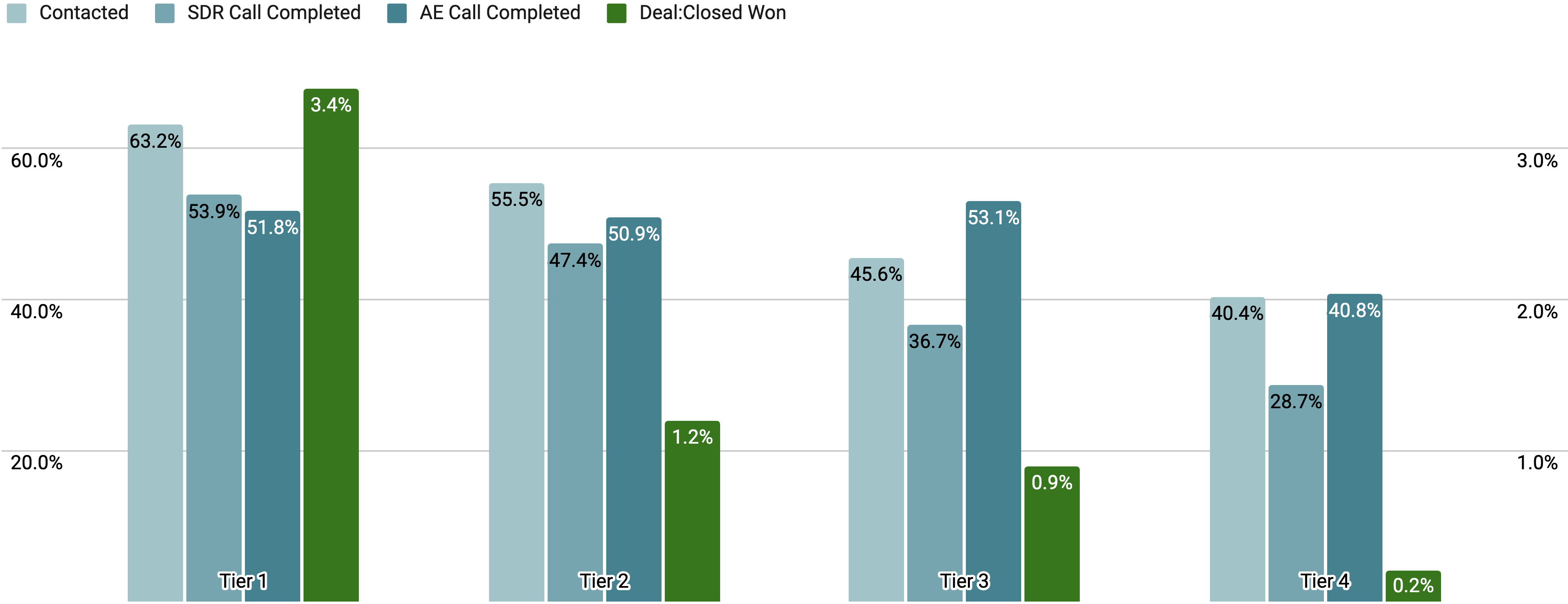- 10 minutes to read
Lead scoring is a crucial component of any successful inbound marketing campaign. It helps you prioritize and qualify leads based on their level of engagement with your brand. In this article, we’ll discuss what lead scoring is, how it works, and the benefits it can bring to your business. We’ll also explore strategies for implementing and enhancing your lead scoring program, as well as how to analyze the results. Lead scoring, lead grading, and lead tiering are essential components of any successful lead generation strategy. These processes help businesses to identify and prioritize high-quality leads, which can ultimately lead to increased revenue and growth. Lead scoring is a powerful tool that can help you to better understand your leads and their level of engagement with your brand. While they share similarities, they have distinct definitions and purposes:
Lead scoring: Method used to assign a numerical value or score to leads based on specific criteria. It involves evaluating various attributes and behaviors of a lead to determine their level of interest and readiness to make a purchase.
Lead grading: Process that assesses leads based on predefined criteria to determine their overall quality. Unlike lead scoring, which focuses on the level of interest and readiness, lead grading evaluates the potential value and fit of a lead with the target audience or ideal customer profile (ICP).
Lead tiering: Categorization process that groups leads into different tiers or segments based on their characteristics and potential value. It involves dividing leads into distinct categories to prioritize and allocate resources effectively.
Benefits of Lead Scoring, Lead Grading and Lead Tiering
Lead scoring, grading, and tiering can bring a number of benefits to your business. These include:
- Increased efficiency: By focusing your efforts on the most promising leads, you can save time and resources.
- Better alignment between marketing and sales: By using a shared lead scoring system, you can ensure that marketing is generating leads that meet the criteria agreed upon by sales.
- Improved lead nurturing: By using lead scoring, grading, and tiering, you can better tailor your messaging to the needs and interests of each lead.
- Increased revenue: By focusing on higher quality leads, you can increase your conversion rates and ultimately drive more revenue for your business.
Let’s dive deeper into each of these benefits:
Increased Efficiency
Lead scoring, grading, and tiering allow you to prioritize your leads and focus your efforts on the most promising ones. This means you can save time and resources by not wasting them on leads that are unlikely to convert. By identifying the leads that are most likely to become customers, you can focus your attention on them and increase your chances of success.
Better Alignment Between Marketing and Sales
Lead scoring, grading, and tiering provide a shared language for marketing and sales to use when discussing leads. By agreeing on a set of criteria for what makes a lead “good”, marketing can generate leads that are more likely to be successful for sales. This alignment ensures that the leads generated by marketing are more likely to be accepted and acted upon by sales, resulting in a more efficient and effective lead management process.
Improved Lead Nurturing
Lead scoring, grading, and tiering allow you to segment your leads based on their level of engagement and interest. This means you can tailor your messaging to the specific needs and interests of each lead, increasing the chances that they will engage with your company and ultimately convert into customers. By providing relevant and targeted content to your leads, you can build trust and credibility with them, making them more likely to choose your company when they are ready to make a purchase.
Increased Revenue
By focusing on higher quality leads, you can increase your conversion rates and ultimately drive more revenue for your business. By identifying the leads that are most likely to convert, you can focus your efforts on them and increase your chances of success. This means you can generate more revenue with the same amount of resources, resulting in a higher return on investment for your lead generation efforts.
Overall, lead scoring, grading, and tiering are powerful tools that can help you streamline your lead management process, improve your alignment between marketing and sales, and ultimately drive more revenue for your business.
How to Implement Lead Scoring, Lead Grading and Lead Tiering
If you’re just starting out with lead scoring, grading, and tiering, it can seem like a daunting task. But with the right tools and approach, it can be relatively straightforward.
The first step is to establish clear criteria for lead scoring and grading. This may involve collaborating with your sales team to understand what characteristics they look for in high-quality leads. For example, you may want to consider factors such as job title, company size, and budget. You should also consider the specific actions that indicate a lead is engaged with your brand, such as downloading a whitepaper or attending a webinar. By combining demographic and behavioral data, you can create a more accurate and comprehensive lead scoring system.
Once you’ve established your criteria, you’ll need to implement a lead scoring system. This can be done manually using spreadsheets, but most marketing automation tools include lead scoring functionality as a standard feature. By using a marketing automation tool, you can automate the lead scoring process and ensure that your leads are scored consistently and accurately. You’ll also need to ensure that your sales team is trained on how to use the lead scoring system and understand the criteria that have been established.
But how do you know if your lead scoring system is working effectively? This is where lead grading comes in. Lead grading is the process of assigning a letter grade to a lead based on its score. For example, an A-grade lead may be ready for immediate follow-up, while a C-grade lead may need more nurturing before it’s ready to be passed to sales. By using lead grading, you can prioritize your leads and ensure that your sales team is focusing on the most promising opportunities.
Finally, you’ll need to establish a process for lead tiering. This may involve grouping leads into different categories based on their level of engagement or fit, and tailoring your outreach efforts accordingly. For example, you may want to create different tiers based on the lead’s job title or company size. By tailoring your outreach efforts to each tier, you can increase the effectiveness of your lead generation efforts and improve your overall conversion rates.
In conclusion, implementing lead scoring, grading, and tiering can be a powerful way to improve the effectiveness of your lead generation efforts. By establishing clear criteria, using a marketing automation tool, and implementing lead grading and tiering, you can ensure that your sales team is focusing on the most promising opportunities and increase your overall conversion rates.
Analyzing Results from Lead Scoring, Lead Grading and Lead Tiering
Lead scoring, grading, and tiering are essential components of any successful inbound marketing program. They help you prioritize your leads and focus your efforts on those most likely to convert into customers. However, to ensure that these processes are performing as effectively as possible, ongoing analysis and optimization are critical.
One of the first things you should do is review your lead scoring criteria regularly. As your business evolves, so too may the characteristics of your ideal customer. By analyzing your leads and their behavior, you can adjust your scoring criteria to reflect these changes and ensure that you’re targeting the right prospects.
Another important aspect of analyzing your lead scoring, grading, and tiering results is examining how your leads are moving through your funnel. Are there any bottlenecks or areas where leads are dropping off? If so, you may need to adjust your scoring and grading criteria to better reflect the attributes of leads that are most likely to move through your funnel successfully.
Looking at this example from a real partner, we’ve aligned sales and have them prioritize leads based on their score. This data is was generated from leads attained before we had any prioritization in place, and we can very clearly see better conversion rates across most metrics, specially in Deal to Closed Won (CW) conversion, – when a lead converts into a customer – where deals convert into paying customers up to 15 times better:

It’s also important to look at the quality of your leads. Are you generating a lot of leads, but few of them are converting into customers? If so, you may need to adjust your scoring criteria to focus on leads that are more likely to be a good fit for your business.
Finally, analyzing your lead scoring, grading, and tiering results can help you identify opportunities for improvement in your overall inbound marketing strategy. By understanding which channels are generating the highest-quality leads and which are falling short, you can adjust your tactics and focus your efforts where they’re most likely to be effective.
In conclusion, analyzing your lead scoring, grading, and tiering results is critical to ensuring that you’re generating high-quality leads that are likely to convert into customers. By regularly reviewing and adjusting your criteria, examining how your leads are moving through your funnel, and looking at the quality of your leads, you can optimize your inbound marketing program and drive better results for your business.
Strategies for Increasing Lead Scoring, Lead Grading and Lead Tiering
Once you’ve established your lead scoring, grading, and tiering program, there are a number of strategies you can use to enhance its effectiveness.
- Refine your criteria: Regularly review and refine your lead scoring and grading criteria to ensure they’re still effective.
- Use personalization: Use the data you’ve collected through lead scoring, grading, and tiering to personalize your messaging and tailor it to each lead’s needs and interests.
- Collaborate with sales: Regularly collaborate with your sales team to understand what’s working and what’s not, and make adjustments as needed.
- Automate where possible: Use marketing automation tools to automate as much of the lead scoring and tiering process as possible, freeing up your team to focus on more strategic activities.
Conclusion
Lead scoring, grading, and tiering are critical components of any successful inbound marketing program. By using these tactics, you can more effectively prioritize and qualify your leads, leading to increased efficiency, better alignment between marketing and sales, and ultimately, increased revenue for your business. The key is to establish clear criteria, implement a system for scoring and grading, regularly analyze your results and optimize accordingly, and collaborate with your sales team to ensure that everyone is aligned.





